If you’re a guy who wants to build muscle and lose fat quickly, you’re in the right place.
This male 3-month body transformation plan teaches you how to carve out a fitter physique in just 12 weeks.
Read on to learn which exercises you need to do to rapidly build muscle, how to structure cardio workouts to help you lose fat like clockwork, the best diet and supplements for boosting your progress, and more.
The Ultimate 3-Month Body Transformation Plan for Men
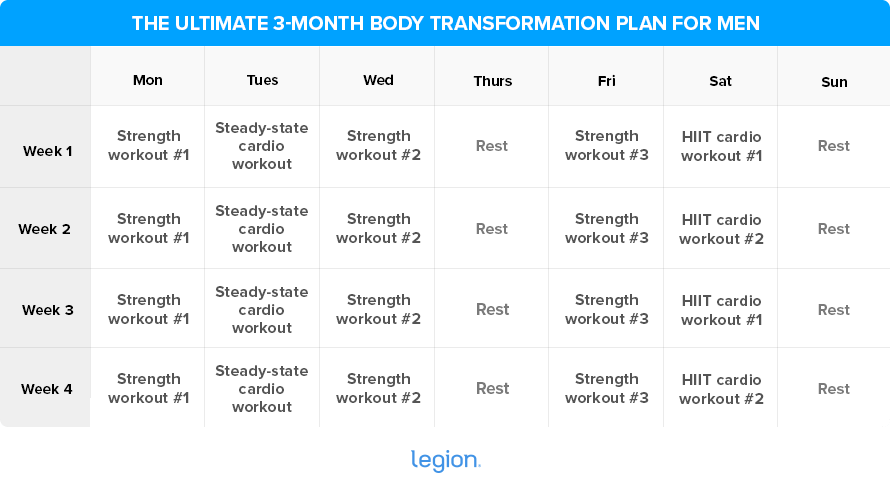
This male 3-month body transformation plan includes the perfect mix of strength training and cardio to transform your body fast. The schedule above shows you how to organize your training for 4 weeks; all you have to do is follow it exactly and repeat it three times back-to-back.
Don’t skip your rest days, either. This beginner workout plan for men is short and intense, so you have to give your body time to recover to maximize your results.
Strength Workouts
Most workout routines for men to lose weight and build muscle emphasize high-rep, pump-style training and recommend doing too many machine and isolation exercises.
This is a mistake.
If you want to maximize the fat-burning effects of strength training, here’s what you need to focus on:
- Compound exercises: A compound exercise is any exercise that targets multiple muscle groups at once, such as the squat, deadlift, and bench and overhead press.
Studies show that compound exercises produce the greatest increases in metabolic rate, muscle mass, and strength, which means they’re the best type of exercise for increasing fat loss.
- Heavy weightlifting: Research shows that lifting weights 75-to-85% of your one-rep max (weights that you can do 6-to-12 reps with before failing) helps you build more muscle and burn more fat than training with lighter weights.
- Progressive overload: The best way to build muscle and thus maximize the fat-burning effects of weightlifting is to strive to add weight or reps to every exercise in every workout. This is known as progressive overload, and it’s the single most important driver of muscle growth.
The classic “push pull legs” routine is the basis for this 3-month workout plan because it emphasizes upper-body training, which is the area of the body most men want to develop, while including enough lower-body work to ensure you build a balanced physique.
Do the workouts exactly as they’re laid out, using the rep ranges and rest times provided.
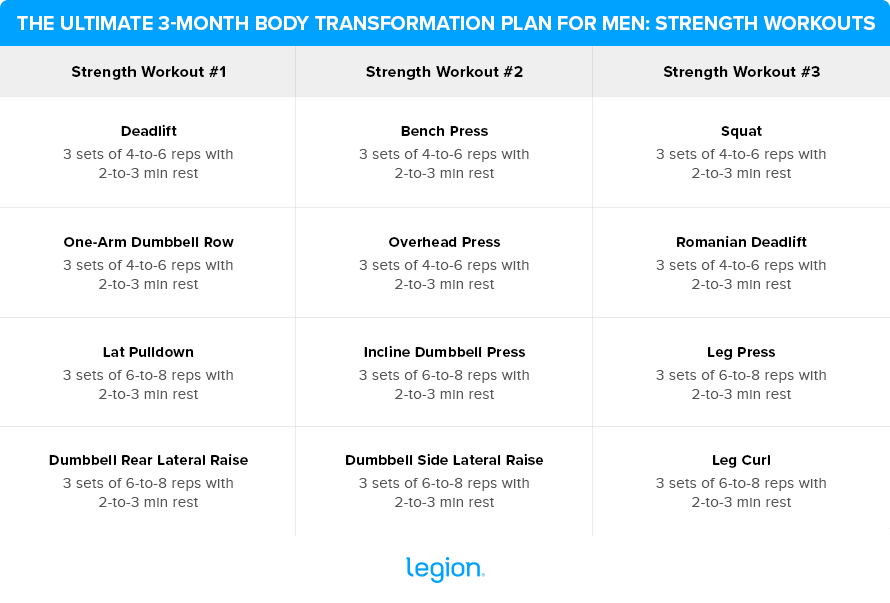
And if you like the look of this program, but want even more options, including a 4- and 5-day workout routine for men to lose weight and build muscle, check out my best-selling fitness book for men, Bigger Leaner Stronger.
(Or if you’d like even more specific advice about what strength training program is right for your circumstances and goals, take the Legion Strength Training Quiz, and in less than a minute, you’ll know the perfect strength training program for you. Click here to check it out.)
Here’s how to do each exercise:
Deadlift
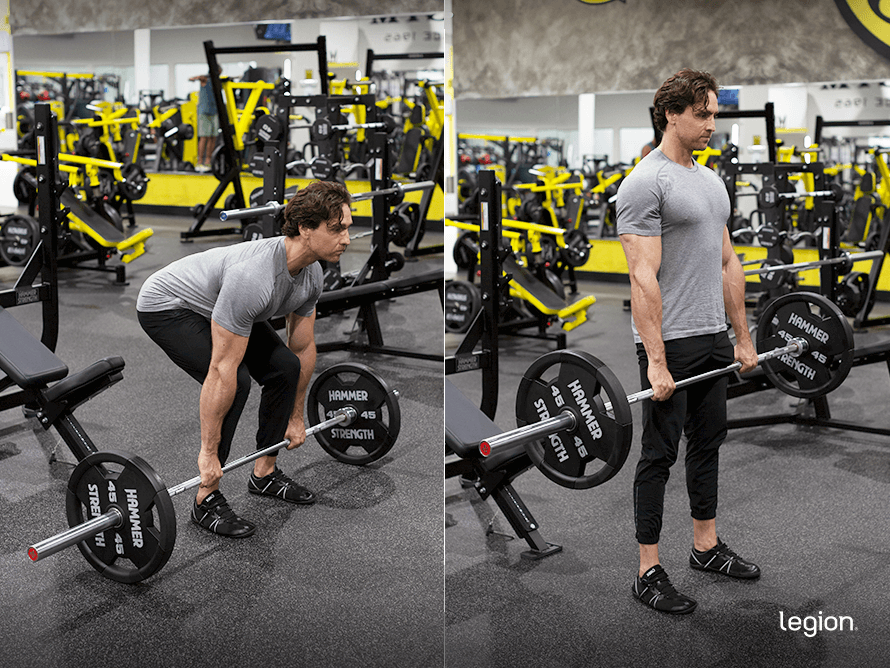
- Position your feet slightly narrower than shoulder-width apart with your toes pointed slightly out. Move a loaded barbell over your midfoot, so it’s about an inch from your shins.
- Take a deep breath into your belly, then place your hands on the bar just outside your shins with your palms facing you.
- Flatten your back and drive your body upward and slightly back by pushing through your heels until you’re standing up straight.
- Reverse the movement and return to the starting position.
Tip: If you can’t do conventional deadlifts, try the sumo or trap-bar deadlift instead. They’re both as effective as the conventional deadlift, but some people find them more comfortable.
One-Arm Dumbbell Row
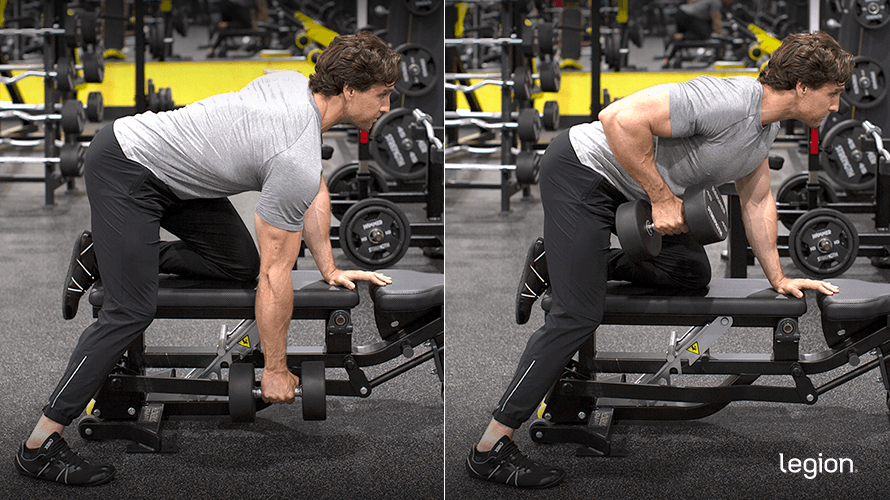
- Hold a dumbbell in your right hand.
- Plant your left knee and hand firmly on a bench, your right foot on the floor a foot or two from the bench, and let your right arm (the one holding the dumbbell) hang straight down toward the floor).
- Keeping your back straight, pull the dumbbell upward until it touches your torso, and then return the dumbbell to the starting position.
- Once you’ve completed the desired number of reps, repeat the process with your left arm.
Lat Pulldown
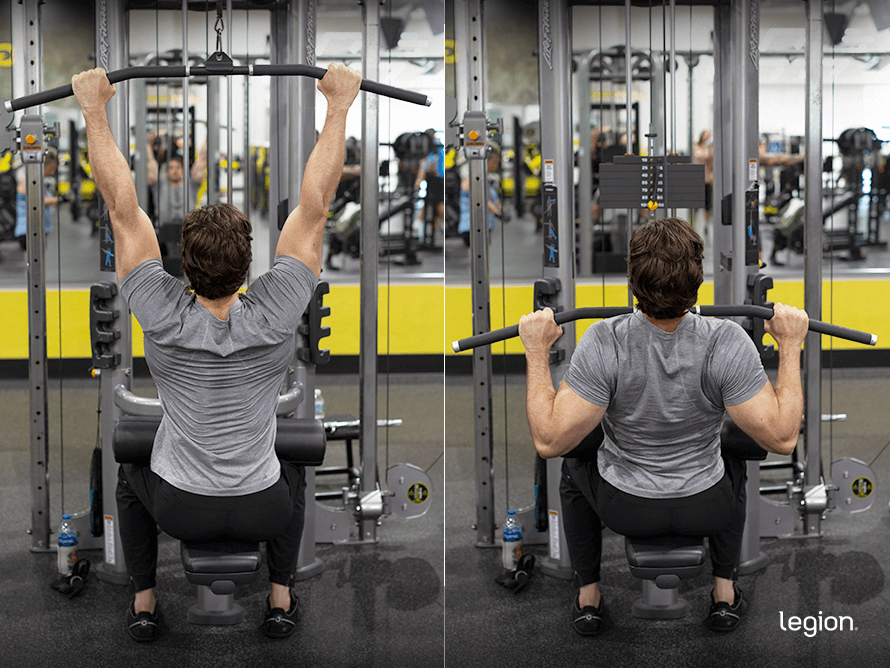
- Adjust the thigh pad of a lat pulldown machine so that it locks your lower body in place.
- Stand up and grab the bar. While keeping your grip on the bar and your arms straight, sit down, allowing your body weight to pull the bar down with you.
- Nudge your thighs under the thigh pads and plant your feet flat on the floor.
- Pull the bar toward your chest.
- Once the bar is underneath your chin (or touches your chest, if you want to make the exercise harder), reverse the movement and return to the starting position.
Dumbbell Rear Lateral Raise
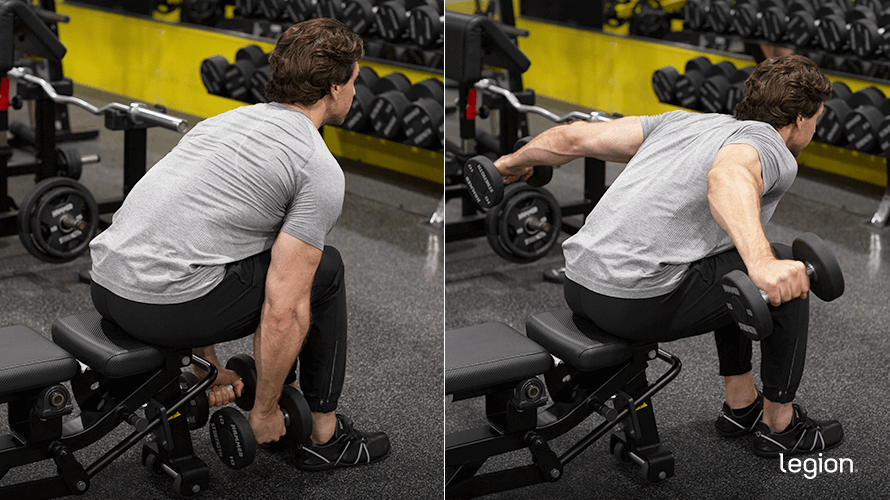
- Whether standing or seated, bend at the hips so your upper body is as close to parallel to the floor as possible.
- Hold a dumbbell in each hand, and while keeping your back flat, lift the dumbbells out to the side until your upper arm is parallel to the floor.
- You don’t have to keep your arms perfectly straight—having a slight bend in your elbows is usually more comfortable.
- Reverse the movement and return to the starting position.
Bench Press
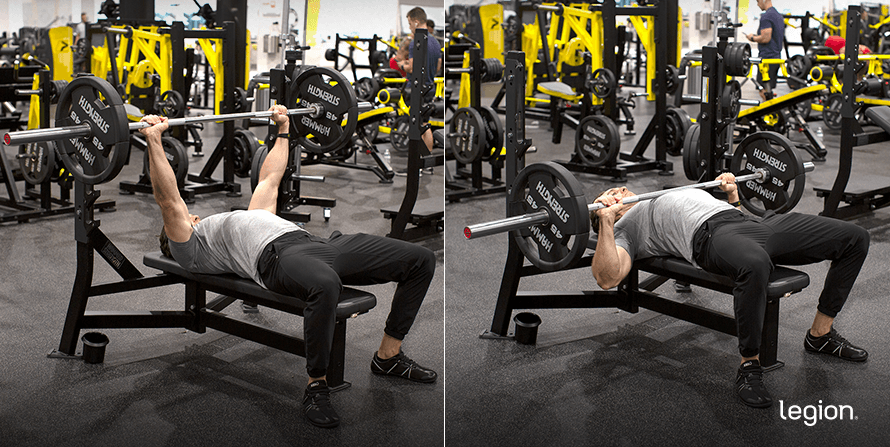
- Lie on a flat bench with your feet flat on the floor, directly under your knees.
- Pull your shoulder blades together and down, and without lifting your butt or shoulders off the bench, slightly arch your back.
- Grab the bar with your hands slightly wider than shoulder-width apart, take a deep breath, brace your core, and unrack the barbell.
- Bring the barbell to the middle of your chest, making sure to keep your elbows tucked at about a 45-degree angle relative to your body.
- When the bar touches your chest, explosively press the bar back to the starting position.
Overhead Press
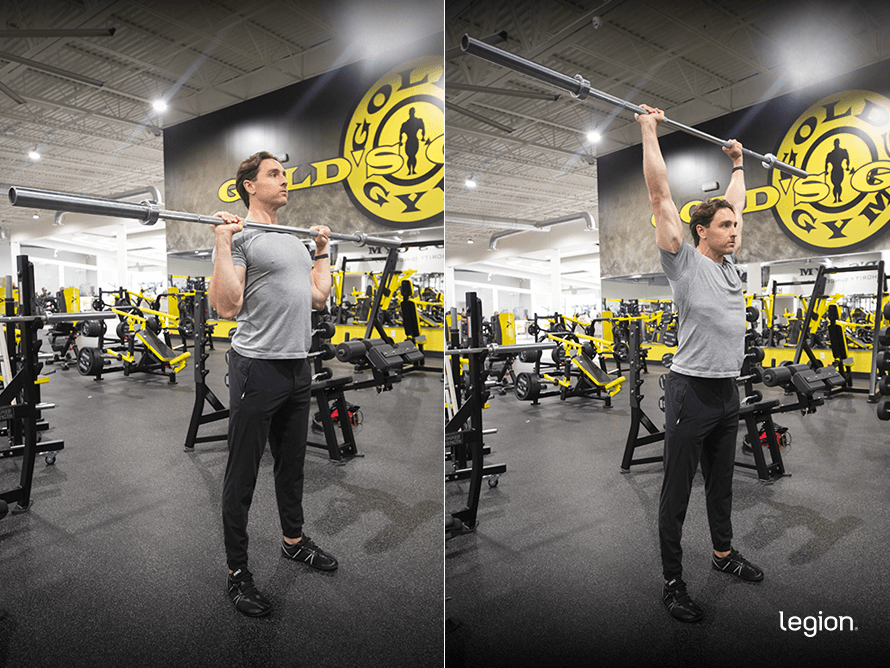
- Set a barbell in a rack at the same height as your upper chest.
- Grip the bar with a shoulder-width grip and your palms facing away from you.
- Unrack the barbell and take a small step backward with each foot, keeping your wrists stacked over your elbows, and your elbows tucked close to your sides.
- Plant your feet just outside of shoulder-width, and arch your upper back enough so the bar is directly over your midfoot and your head is slightly behind the bar.
- Take a deep breath into your stomach and tighten your core muscles, squeeze your glutes as hard as you can, and push the bar off your chest toward the ceiling.
- Once your arms are straight and your elbows are locked out, reverse the movement to return to the starting position.
Incline Dumbbell Bench Press
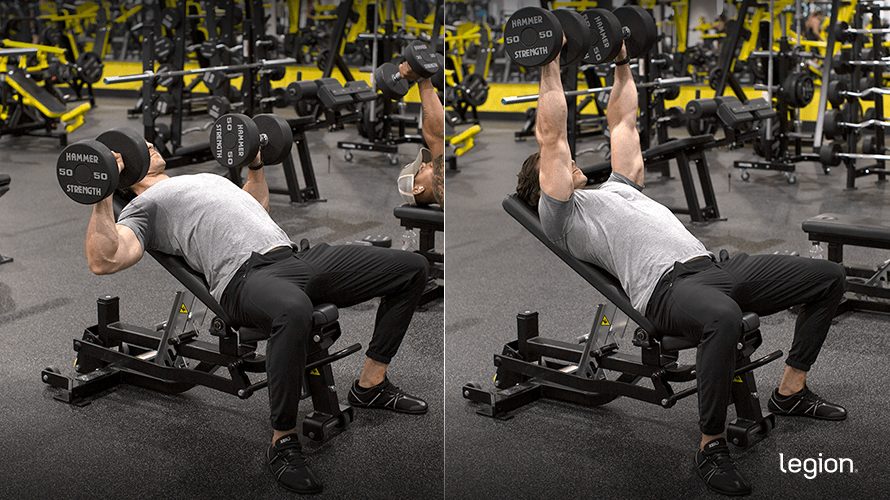
- While lying on a bench that’s angled at 30-to-45 degrees, hold a dumbbell in each hand and rest them on your thighs.
- Lie back, hoisting the dumbbells up so you’re holding them on either side of your chest by giving them a nudge with your thighs.
- Press the dumbbells straight up over your upper chest until your arms are straight and your elbows are locked.
- Lower the dumbbells to the starting position.
Dumbbell Side Lateral Raise
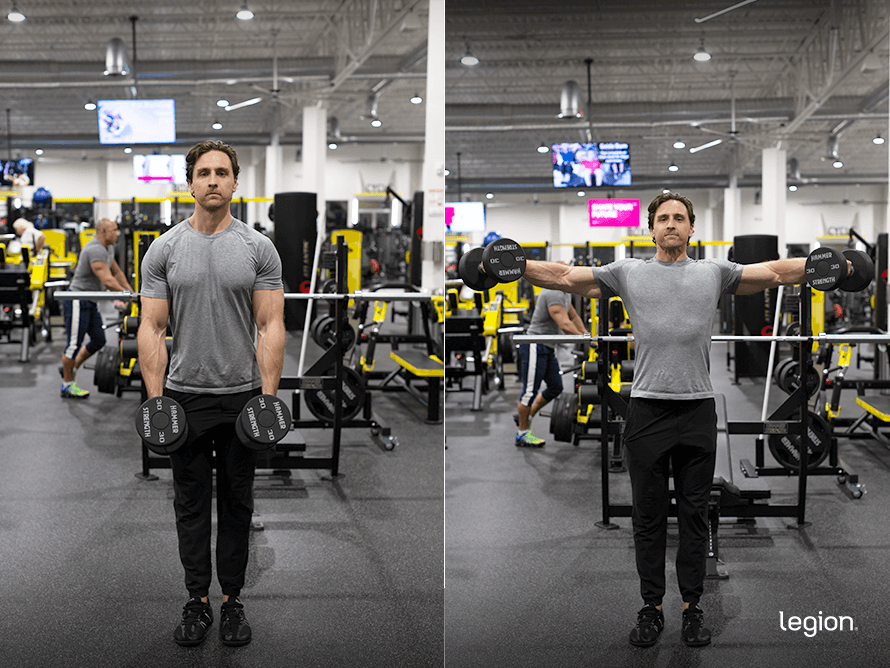
- Stand up straight with a dumbbell in each hand.
- Keeping your back straight and your core tight, raise the dumbbells out to the side until your upper arm is parallel to the floor. You don’t have to keep your arms perfectly straight—having a small bend in your elbows is normally more comfortable.
- Reverse the movement and return to the starting position.
Squat
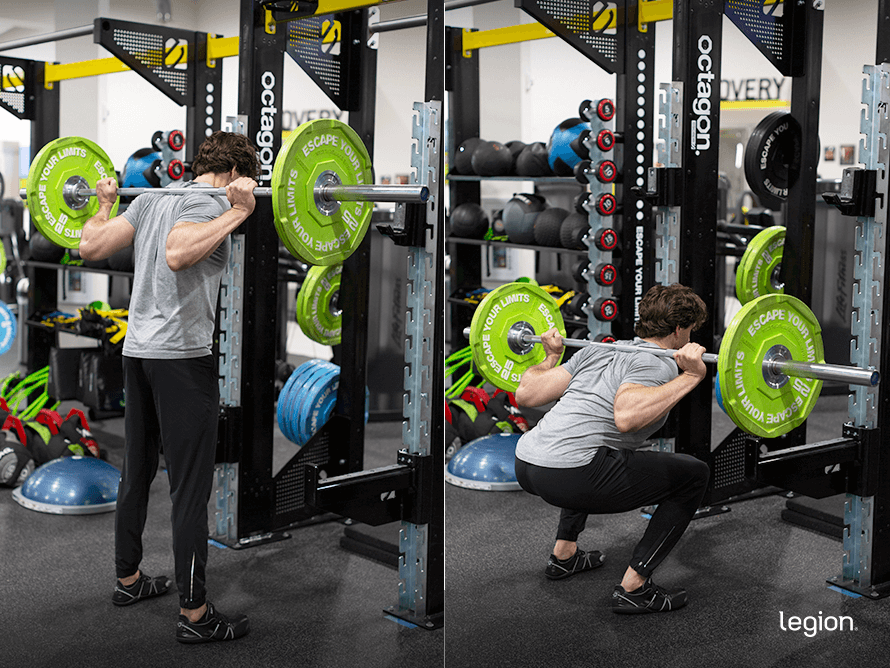
- Position a barbell in a squat rack at about the height of the top of your breastbone.
- Step under the bar, pinch your shoulder blades together, and rest the bar directly above the bony ridges on the bottom of your shoulder blades.
- Lift the bar out of the rack, take one or two steps backward, and place your feet a little wider than shoulder-width apart, with your toes pointing slightly outward.
- Sit down and remember to keep your back straight and push your knees out in the same direction as your toes throughout each rep.
- Stand up and return to the starting position.
Romanian Deadlift
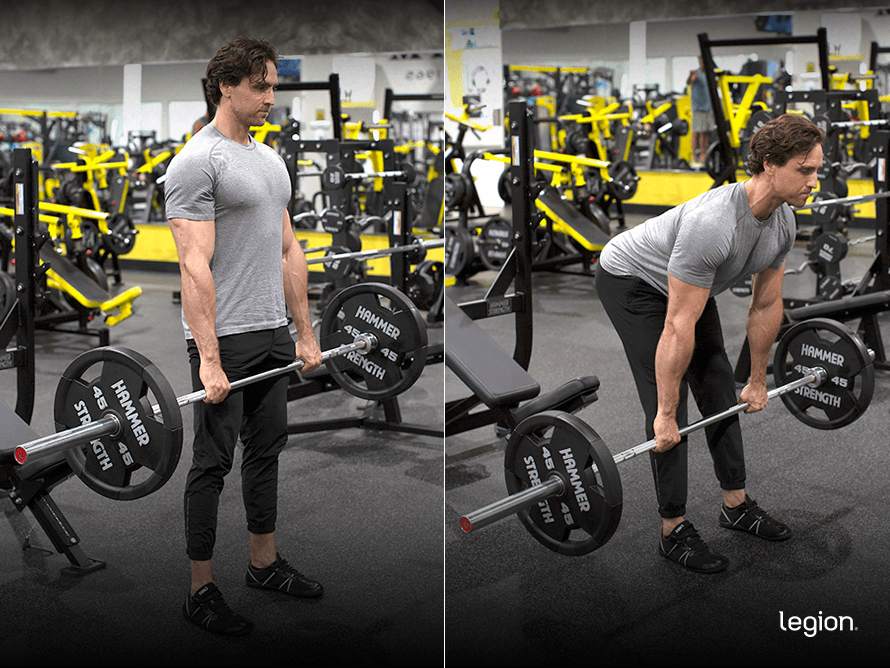
- Stand up straight holding a loaded barbell with a shoulder-width, overhand grip (palms facing toward your body).
- Flatten your back and lower the weights toward the floor in a straight line while keeping your legs mostly straight, allowing your butt to move backward as you descend.
- Once you feel a stretch in your hamstrings, bend your knees slightly more, and continue lowering the weights until your lower back begins to round—just below the knees for most people and about mid-shin for those who are particularly flexible.
- Reverse the movement and return to the starting position.
Leg Press
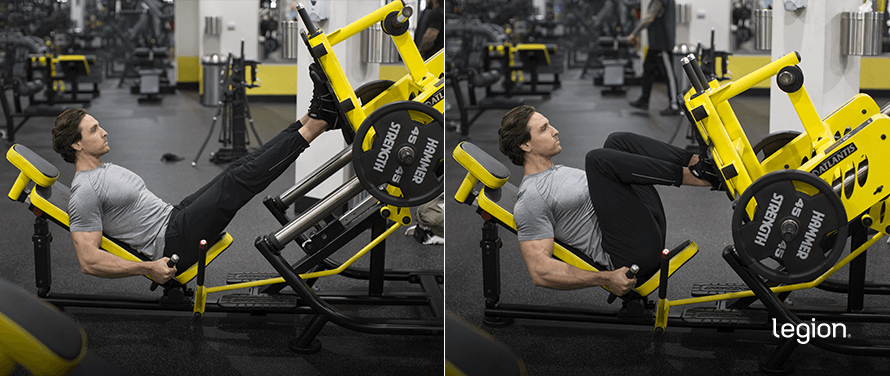
- Load a leg press with plates and adjust the seat to its lowest position (with the backrest closest to the floor, at about a 30-degree angle).
- Wedge your butt down into the base of the seat and plant your feet on the footplate just outside of shoulder-width apart.
- Bend your knees slightly, use the safety handles to release the weight, and lower the footplate toward your chest until your thighs are 12-to-16 inches from your torso.
- Make sure your butt remains firmly in place and your lower back doesn’t round at the bottom of the rep.
- Finally, push the footplate upward until your legs are almost but not completely straight (knees slightly bent at the top of the rep).
Leg Curl
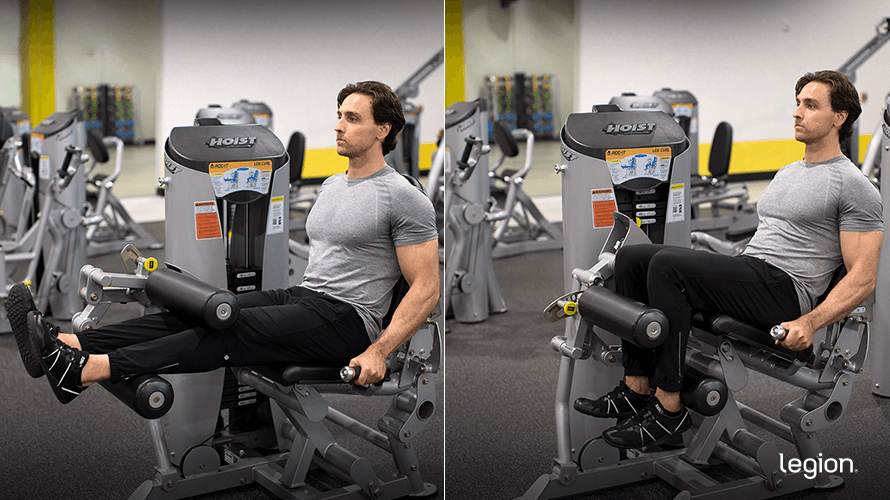
- Sit on the machine with the back of your knees a couple of inches off the pad supporting your thighs and adjust the heel pad so it’s across your Achilles tendons.
- Press your heels toward your butt until your shins are roughly perpendicular to your thighs (or closer)
- Raise your heels and return to the starting position.
3 Tips for More Productive Strength Workouts
1. End every set 1-to-2 reps shy of muscle failure.
To maximize muscle and strength gains, you need to take most of your sets close (but not all the way) to muscle failure, which is the point at which you can’t complete a rep despite giving maximum effort.
To ensure you’re taking your sets close enough to failure, ask yourself this question at the end of each set, just before re-racking the weight: “If I absolutely had to, how many more reps could I get with good form?”
If the answer is more than two, increase the weight or reps to make your next set more challenging. This ensures you include the right balance of volume and intensity in your workouts.
2. Once you hit the top of your rep range for one set, move up in weight.
For instance, let’s say your workout calls for 4-to-6 reps of deadlift (as this one does). If you get 6 reps for a set, add 5 pounds to each side of the bar (10 pounds total) for your next set and work with that weight until you can (eventually) pull it for 6 reps, and so forth.
If you get 3 or fewer reps with your new (higher) weight on your next sets, reduce the weight by 5 pounds to ensure you can stay within your target rep range (4-to-6) for all sets.
Follow this same pattern of trying to add reps or weight to every exercise in every workout. This method is known as double progression, and it’s a highly effective way to get fitter and stronger.
3. Rest at least 2-to-3 minutes between sets.
This will give your muscles enough time to fully recoup their strength so you can give maximum effort each set.
That said, if you’re feeling gassed between heavy sets of compound exercises like the squat or deadlift, it’s probably best to rest a little longer—anywhere from 3-to-5 minutes should do the trick.
Cardio Workouts
You’ve probably heard that you have to do a lot of cardio to get in shape.
This is nonsense.
While cardio helps you burn calories and thus contributes to fat loss, too much can interfere with your body composition goals by hindering your ability to build muscle. It does this in two ways:
- It makes you more generally fatigued, which makes it harder to progress in your weightlifting workouts.
- It disrupts cell signaling related to muscle growth.
Get the balance between weightlifting and cardio correct, however, and you’ll maximize your health and fitness.
In this 3-month weight loss workout plan for men, you’ll do just two cardio workouts per week: One at a low-to-moderate intensity and another at a high intensity. This is enough to facilitate fat loss and improve cardiovascular health without hampering muscle and strength gain.
Here’s how to do the cardio workouts:
Steady-State Cardio Workout
For your steady-state cardio workout, spend 30-to-60 minutes doing low-impact exercise that you enjoy, like walking, swimming, cycling, or rucking.
HIIT Cardio Workout #1: 6 x 30
- On an exercise bike or rowing machine, do a 30-second sprint at about 90% of your max effort, followed by 2 minutes of low-intensity recovery.
- Repeat 6 times for a total of 15 minutes of exercise.
HIIT Cardio Workout #2: 10 x 1
- On an exercise bike or rowing machine, do a 1-minute sprint at about 90% of your max effort, followed by 1 minute of low-intensity recovery.
- Repeat 10 times for a total of 20 minutes of exercise.
Diet and Nutrition
1. Eat the right number of calories.
Ordinarily, if you want to lose fat, you need to consume fewer calories than you burn (also known as a calorie deficit), and if you want to build muscle, you need to eat slightly more calories than you burn (also known as a calorie surplus).
However, when you’re new to weightlifting, your body is hyper-responsive to the muscle-building effects of resistance training, which means you can build muscle even when you’re in a calorie deficit.
This is why you can transform your body rapidly when you first start training consistently.
Research shows that if you want to maximize fat loss while still gaining muscle during this “newbie gains” phase, you need to use an aggressive (but not reckless) calorie deficit.
This is why I recommend setting your calorie deficit at 20-to-25% (eat 20-to-25% fewer calories than you burn every day).
(And if you’d like even more specific advice about how many calories, how much of each macronutrient, and which foods you should eat to reach your goals, take the Legion Diet Quiz.)
2. Eat enough protein.
Eating enough protein helps you recover faster from your workouts, gain muscle and lose fat faster, retain muscle while dieting, and feel more satiated by your meals (and thus less likely to overeat).
To transform your body as quickly as possible, then, you should eat about 1-to-1.2 grams per pound of body weight per day.
And if you’re very overweight (30%+ body fat), reduce this to around 40% of your total daily calories.
(Again, if you feel confused about how many calories, how much of each macronutrient, and which foods you should eat to reach your goals, take the Legion Diet Quiz to learn exactly what diet is right for you.)
3. Take the right supplements.
No weight loss pills and powders are going to automagically transform your body.
In fact, most fat loss supplements are completely worthless.
That said, if you know how to eat and train to drive fat loss—following the steps we just covered—certain supplements can speed up the process. (And if you’d like to know exactly what supplements to take to reach your fitness goals, take the Legion Supplement Finder Quiz.)
Here are the best supplements to help you build muscle and lose fat:
- 0.8-to-1.2 grams of protein per pound of body weight per day. This provides your body with the “building blocks” it needs to build and repair muscle tissue and help you recover from your workouts. If you want a clean, convenient, and delicious source of protein, try Whey+ or Casein+.
- 3-to-5 grams of creatine per day. This will boost muscle and strength gain, improve anaerobic endurance, and reduce muscle damage and soreness from your superset workouts. If you want a 100% natural source of creatine that also includes two other ingredients that will help boost muscle growth and improve recovery, try Recharge.
- One serving of Phoenix per day. Phoenix is a 100% natural fat burner that speeds up your metabolism, enhances fat burning, and reduces hunger and cravings. You can also get Phoenix with caffeine or without.
+ Scientific References
- Farinatti, P. T. V., & Castinheiras Net, A. G. (2011). The effect of between-set rest intervals on the oxygen uptake during and after resistance exercise sessions performed with large- and small-muscle mass. Journal of Strength and Conditioning Research, 25(11), 3181–3190. https://doi.org/10.1519/JSC.0B013E318212E415
- Marx, J. O., Ratamess, N. A., Nindl, B. C., Gotshalk, L. A., Volek, J. S., Dohi, K., Bush, J. A., Gómez, A. L., Mazzetti, S. A., Fleck, S. J., Häkkinen, K., Newton, R. U., & Kraemer, W. J. (2001). Low-volume circuit versus high-volume periodized resistance training in women. Medicine and Science in Sports and Exercise, 33(4), 635–643. https://doi.org/10.1097/00005768-200104000-00019
- Schoenfeld, B. J. (2010). The mechanisms of muscle hypertrophy and their application to resistance training. Journal of Strength and Conditioning Research, 24(10), 2857–2872. https://doi.org/10.1519/JSC.0B013E3181E840F3
- Schoenfeld, B. J., Pope, Z. K., Benik, F. M., Hester, G. M., Sellers, J., Nooner, J. L., Schnaiter, J. A., Bond-Williams, K. E., Carter, A. S., Ross, C. L., Just, B. L., Henselmans, M., & Krieger, J. W. (2016). Longer Interset Rest Periods Enhance Muscle Strength and Hypertrophy in Resistance-Trained Men. Journal of Strength and Conditioning Research, 30(7), 1805–1812. https://doi.org/10.1519/JSC.0000000000001272
- Murach, K. A., & Bagley, J. R. (2016). Skeletal Muscle Hypertrophy with Concurrent Exercise Training: Contrary Evidence for an Interference Effect. Sports Medicine (Auckland, N.Z.), 46(8), 1029–1039. https://doi.org/10.1007/S40279-016-0496-Y
- Jones, T. W., Howatson, G., Russell, M., & French, D. N. (2013). Performance and neuromuscular adaptations following differing ratios of concurrent strength and endurance training. Journal of Strength and Conditioning Research, 27(12), 3342–3351. https://doi.org/10.1519/JSC.0B013E3181B2CF39
- Ho, S. S., Dhaliwal, S. S., Hills, A. P., & Pal, S. (2012). The effect of 12 weeks of aerobic, resistance or combination exercise training on cardiovascular risk factors in the overweight and obese in a randomized trial. BMC Public Health, 12(1), 1–10. https://doi.org/10.1186/1471-2458-12-704/FIGURES/3
- Brellenthin, A. G., Lee, D. C., Bennie, J. A., Sui, X., & Blair, S. N. (2021). Resistance exercise, alone and in combination with aerobic exercise, and obesity in Dallas, Texas, US: A prospective cohort study. PLOS Medicine, 18(6), e1003687. https://doi.org/10.1371/JOURNAL.PMED.1003687
- Demling, R. H., & DeSanti, L. (2000). Effect of a hypocaloric diet, increased protein intake and resistance training on lean mass gains and fat mass loss in overweight police officers. Annals of Nutrition & Metabolism, 44(1), 21–29. https://doi.org/10.1159/000012817
- Tipton, K. D., & Ferrando, A. A. (2008). Improving muscle mass: response of muscle metabolism to exercise, nutrition and anabolic agents. Essays in Biochemistry, 44, 85–98. https://doi.org/10.1042/BSE0440085
- Evans, E. M., Mojtahedi, M. C., Thorpe, M. P., Valentine, R. J., Kris-Etherton, P. M., & Layman, D. K. (2012). Effects of protein intake and gender on body composition changes: a randomized clinical weight loss trial. Nutrition & Metabolism, 9(1). https://doi.org/10.1186/1743-7075-9-55
- Helms, E. R., Aragon, A. A., & Fitschen, P. J. (2014). Evidence-based recommendations for natural bodybuilding contest preparation: nutrition and supplementation. Journal of the International Society of Sports Nutrition 2014 11:1, 11(1), 1–20. https://doi.org/10.1186/1550-2783-11-20
- Halton, T. L., & Hu, F. B. (2004). The effects of high protein diets on thermogenesis, satiety and weight loss: a critical review. Journal of the American College of Nutrition, 23(5), 373–385. https://doi.org/10.1080/07315724.2004.10719381
- Stokes, T., Hector, A. J., Morton, R. W., McGlory, C., & Phillips, S. M. (2018). Recent Perspectives Regarding the Role of Dietary Protein for the Promotion of Muscle Hypertrophy with Resistance Exercise Training. Nutrients, 10(2). https://doi.org/10.3390/NU10020180
- Branch, J. D. (2003). Effect of creatine supplementation on body composition and performance: a meta-analysis. International Journal of Sport Nutrition and Exercise Metabolism, 13(2), 198–226. https://doi.org/10.1123/IJSNEM.13.2.198
- Eckerson, J. M., Stout, J. R., Moore, G. A., Stone, N. J., Iwan, K. A., Gebauer, A. N., & Ginsberg, R. (2005). Effect of creatine phosphate supplementation on anaerobic working capacity and body weight after two and six days of loading in men and women. Journal of Strength and Conditioning Research, 19(4), 756. https://doi.org/10.1519/R-16924.1
- Bassit, R. A., Pinheiro, C. H. D. J., Vitzel, K. F., Sproesser, A. J., Silveira, L. R., & Curi, R. (2010). Effect of short-term creatine supplementation on markers of skeletal muscle damage after strenuous contractile activity. European Journal of Applied Physiology, 108(5), 945–955. https://doi.org/10.1007/S00421-009-1305-1









